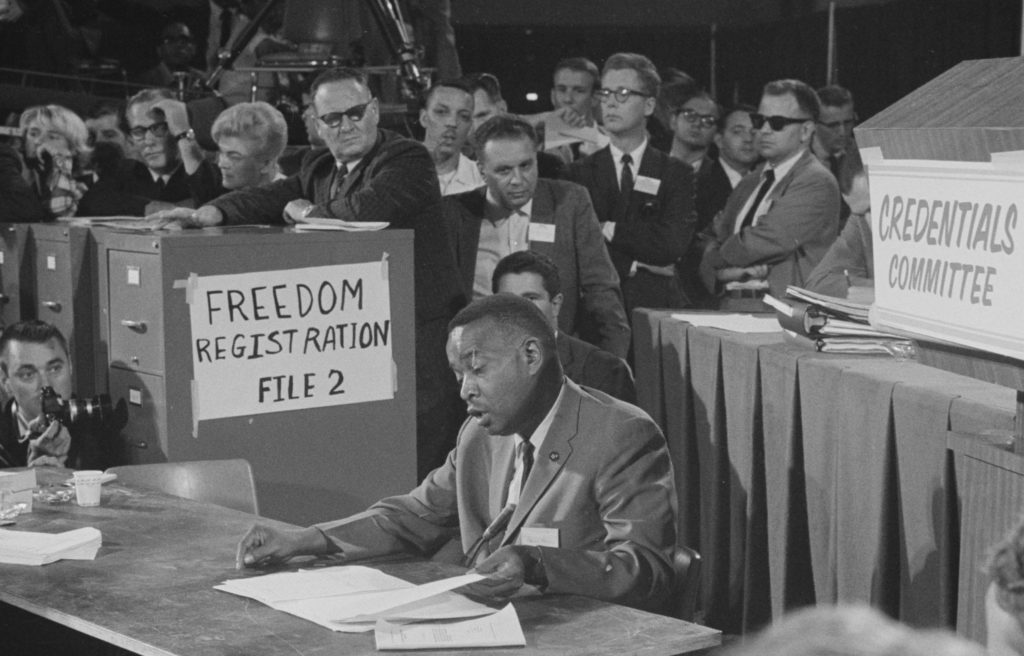In “The White Republic and The Struggle for Racial Justice,” Bob Wing contended that the U.S. state is racist to the core, and this has specific implications for our movements’ work going forward, especially the need to replace this racist state with an anti-racist state. In this response, historian Van Gosse challenges the monolithic picture of the white republic that Wing presents. “[The white republic] has been challenged repeatedly, and sometimes victories have been won. What can we learn from that history?” Gosse asks. OrgUp has published a number of other responses to Bob Wing’s article; we encourage readers to add your voice, and to check out the contributions from Bill Fletcher, Jr., Gerald Horne, Erin Heaney, Peter Olney & Rand Wilson, and Barry Eidlin. This discussion then wraps up with some concluding thoughts by Bob Wing.
Unpacking the republic and learning from victories
I strongly agree with Bob Wing’s formulation that the U.S. has been and is a white republic. I don’t see why this is even a Left stance. Many MAGA supporters would also agree emphatically, adding something like “that’s the history, everyone knows that, what’s the big deal? Why don’t you just accept it,” while the moderates would mewl, “isn’t it generous of us to allow others into the White Republic?”
The real issue here is how you understand the implications of the white republic. In my view, Bob’s articulation is too totalizing. It asserts the white republic as an overwhelming monolith, only briefly challenged. I don’t agree. In my book The First Reconstruction: Black Politics in America, From the Revolution to the Civil War I discuss the books that Bob is drawing on, notably Alexander Saxton’s The Rise and Fall of the White Republic, David Roediger’s The Wages of Whiteness, and Don E. Fehrenbacher’s The Slaveholding Republic. Here’s what I say about them: “Collectively, these books underline that post-revolutionary America began as an imperial White Republic organized around slavery, monolithic racism, and genocidal dispossession of native peoples. Their clear-eyed refusal of a progressive teleology premised on American exceptionalism constitutes a devastating indictment, but one containing a basic weakness: they treat the White Republic as an accomplished fact rather than the program of a powerful but fragile coalition. This premise refuses the possibility that there was more than one republic, let alone a reconstructed Yankee Republic emerging from the Revolution to compete with the ‘slaveholding republic.’” (If you want to read more, here is a preview.)
Bob asserts that the assaults on the white republic were short-lived and unsuccessful. I don’t agree with that formulation either. The original confrontation slowly paralyzed U.S. politics from the late 1830s to 1860, leading to the formation of the only revolutionary party in our history, the Republican Party, unalterably committed to choking off the political economy and system of the slaveholding States. That was not so brief. Further, while formal Reconstruction from 1865 to 1877 certainly was short-lived, it took much longer to destroy Black political power in the former Confederacy. Black men were voting in large numbers in North Carolina until 1900, in Texas and Alabama until 1901, in Virginia until 1902, in Georgia until 1908. The last southern Black congressman, George White, left office in 1901. This was a hard-fought battle, in other words, not a simple rout.
The great migration changes the party system
Bob’s essay also omits a key shift in twentieth-century U.S. politics, the Great Migration out of the Deep South by six million African Americans into states where they could vote—and vote they did. In electoral terms, meaning the exertion of power within the state, the Second Reconstruction began when Oscar DePriest, one of those migrants, was elected to Congress from Chicago in 1928. Ignoring the Great Migration points at another significant ellipsis, the New Deal. Certainly, it was no frontal challenge to white supremacy: FDR accommodated the segregationists and racists who dominated his party in Congress. But the North saw a significant party realignment because of the agency of Black people as voters. In 1936 a majority of Black voters chose FDR because the New Deal in northern states delivered very real benefits to them. Their incorporation into the Democratic Party (and into the CIO unions on which Democrats depended) constituted a body blow to the white republic which white nationalists are still trying to overcome.
The next 28 years, 1936-1964, are the one period in U.S. history when both white-led parties actively competed for Black votes, with lasting consequences. This is the story of the Second Reconstruction as much as the great protest campaigns: the conjuncture of “movement” and politics that forced Truman to go to Harlem and desegregate the military in 1948, impelled Eisenhower to enforce desegregation at Little Rock in 1957, and finally brought passage of the Civil Rights and Voting Rights Acts in 1964-1965 by bipartisan majorities.
Finally, I think Bob’s argument misreads the evolution of our party system. He states, “For much of U.S. history, white racist coalitions dominated both of the main political parties and there was little difference between them on racial policy. The most apparent exceptions were during the Civil War and Reconstruction, and the Civil Rights Era through today,” followed by his statement that “Following the Civil Rights Act in 1965, for the first time in U.S. history, the vast majority of the worst racists and reactionaries migrated to one party, the Republican.” Both of these statements need qualification. Let’s take the second one first. The Democratic Party, from its origins as the Jeffersonian Republican Party in the 1790s (often inaccurately labeled “Democratic-Republican” in textbooks) and even more as the rebranded “Democracy” or Democratic Party under Andrew Jackson in 1828, was the white man’s party straight through to the New Deal, gathering in the main body (or “vast majority”) of racists over that century and more.
Conversely, although Republicans stopped trying to enforce Black voting rights in the South after Democrats filibustered the 1890 Force Bill (a Voting Rights Act for its time), it is not accurate to equate the two. Few African Americans would have agreed with that statement. The Republicans were essentially a Northern party, whereas the Democrats remained the Party of White Supremacy. Frederick Douglass stated it clearly in 1888: “The Republican Party is the ship, all else is the sea.” That stark choice (either hanging on for dear life or drowning) remained the basis of Black political action until the Great Depression combined with the Great Migration forced a slow realignment.
Lessons from close reading of history
To some, this may all seem like a historian’s quibbling around the edges. My goal here is to support and deepen Bob’s thesis. He is dead right that challenging the white republic must center Left politics. I think the way to do so is to unpack and demystify it. It has been challenged repeatedly, and sometimes victories have been won. What can we learn from that history?
Focus on the main enemy and avoid drawing sharp lines with allies. In the 1850s, Senator William Seward and Frederick Douglass hailed each other in public and collaborated in private, despite their radically different positions within U.S. politics.
Pay attention to where executive power resides and how to reach it. Although FDR rarely broke publicly with Southern Democrats in Congress, NAACP Secretary Walter White influenced him in many ways via his close friendship with Eleanor Roosevelt.
Be ready to use confrontation within the party system to send a message. In the 1950s, Harlem’s Democratic Congressman Adam Clayton Powell Jr. was the most powerful African American in national politics. In 1956, to advertise his disgust with Democratic backsliding on civil rights, he endorsed Eisenhower.
Use electoral opportunities to carve open space in party politics. Julian Bond’s 1965 state legislative victory in Georgia was a vital step in confronting racist Democrats in that state, who denied him his seat until the Supreme Court stepped in. The year before, the Mississippi Freedom Democrats sent a biracial delegation to the Democratic National Convention, forcing the national party to finally begin purging all-white Southern “regulars.” Shirley Chisholm’s 1972 presidential campaign challenged the entire left-liberal establishment, Black and white. Finally, there is the Rainbow Coalition, and Reverend Jesse Jackson’s history-making presidential candidacies in 1984 and 1988, which clarified that there really was a significant left pole in U.S. politics, within (or around) the Democratic party.
Let’s start paying attention to our own history, within and against the white republic.
Did you enjoy this article?
We're in the middle of our annual fund drive, and this year we're building our own internal infrastructure for subscriptions, meaning more of every dollar pledged goes to fulfilling our mission. Subscribe today to support our work and be a part of Convergence's next evolution.

